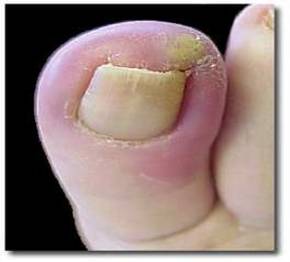Nail surgery
Mr. Ryals has performed well over 2000 nail surgery operations. He regularly see patients who have had failed nail surgery from GP's, other Podiatrists or Surgeons.

Signs and symptoms vary, essentially :-
Ingrown toenails need to be treated to prevent infection and granulation tissue.
What causes an ingrown toenail?
Why have nail surgery?
An ingrown toenail can be a very painful condition. Many people are put off seeking treatment until the nail has deteriorated to a chronic state, usually because of a fear of surgery. Many ingrown toenails can be treated without the need of nail surgery, although conservative measures may mean that you have to visit a Podiatrist at regular intervals. Nail surgery can be performed in Mr. Ryals clinic. The procedure is carried out under local anaesthetic, which offers a more convenient solution than going into hospital, side effects are rare and uncommon. The nail is removed under tourniquet and the nail bed phenolised. Surgery takes approximately five minutes and leaves no scars and produces very good cosmetic appearance. People usually return to normal activities after several days the nail usually heals within 2-3 weeks. You will be able to walk in and walk out of the clinic.
Before surgery Two weeks after nail surgery
- Painful swelling and tenderness at edge of the big toe
- Infection may be present in the form of a small yellow blister
- Weeping (discharge), may be present
- The nail may feel like it is ‘digging’ into the skin
Ingrown toenails need to be treated to prevent infection and granulation tissue.
What causes an ingrown toenail?
- Family history
- Footwear
- Nail involution
- Infection
- Trauma
- Failed surgery (Zadiks procedure)
Why have nail surgery?
An ingrown toenail can be a very painful condition. Many people are put off seeking treatment until the nail has deteriorated to a chronic state, usually because of a fear of surgery. Many ingrown toenails can be treated without the need of nail surgery, although conservative measures may mean that you have to visit a Podiatrist at regular intervals. Nail surgery can be performed in Mr. Ryals clinic. The procedure is carried out under local anaesthetic, which offers a more convenient solution than going into hospital, side effects are rare and uncommon. The nail is removed under tourniquet and the nail bed phenolised. Surgery takes approximately five minutes and leaves no scars and produces very good cosmetic appearance. People usually return to normal activities after several days the nail usually heals within 2-3 weeks. You will be able to walk in and walk out of the clinic.
Before surgery Two weeks after nail surgery

